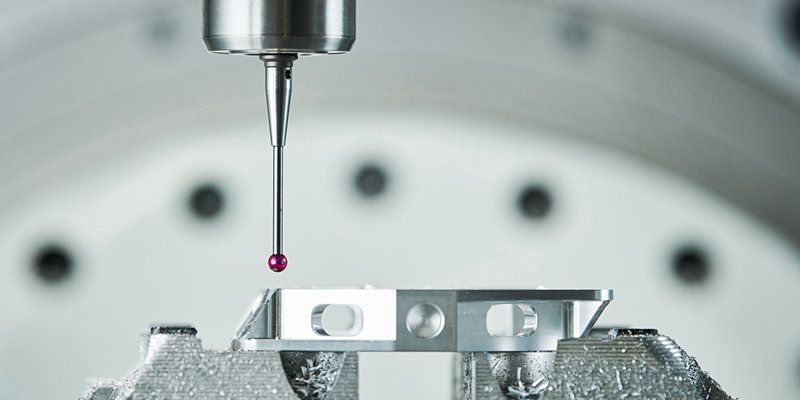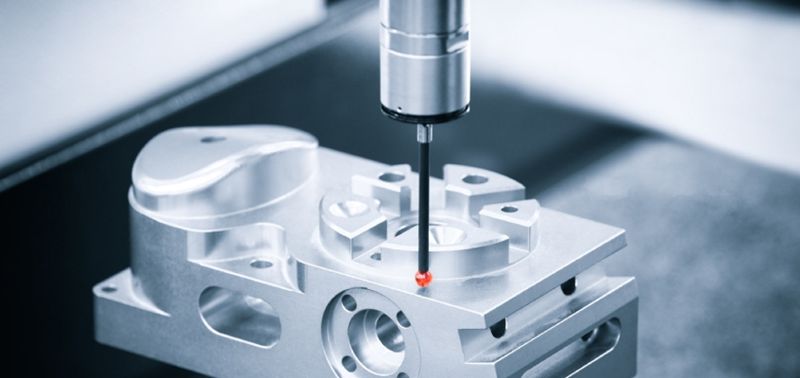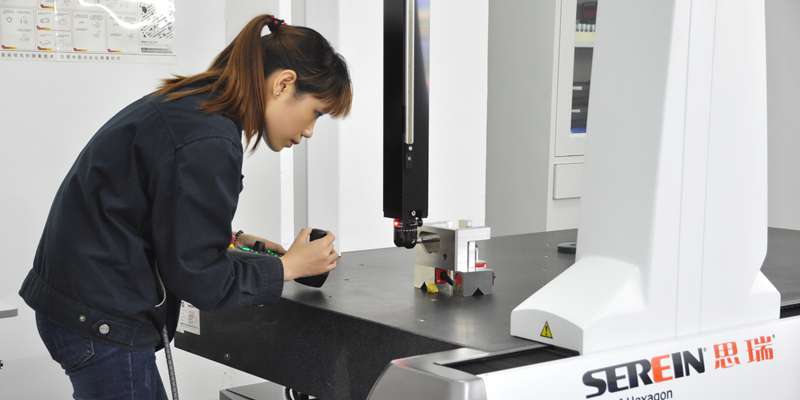Measurements are an integral aspect of parts fabrication, so manufacturers need to minimize errors due to measurement to obtain the desired products. Dimensional errors may affect the entire production process, so it is essential to use top-notch measuring devices, especially when fabricating components with tight tolerance requirements. Hence, use a CMM machine.
A coordinate measuring machine is a manufacturing tool used to accurately measure workpieces and fixtures without slowing the production flow. In this article, we will give more detailed information: “what is a CMM machine?”, its components, and the benefits of this machine.
What is A CMM Machine?
Measurements are essential to any industrial manufacturing process. Depending on what is to be produced, OEMs and parts manufacturers often have to note the dimensions of objects during the fabrication of different components. Such measurements can be obtained using conventional measuring tools like micrometers and calipers or complex devices like a CMM machine.
CMM simply means Coordinate Measuring Machine – a device that accurately measures the dimension and geometry of physical objects or tools. The machine uses a probe, which may be mechanical, or in the form of lasers or lights, to detect discrete points on the object’s surface. Some of these machines are manually controlled, while others are more sophisticated and require computer codes.
 The main advantages of CMM measuring over conventional measuring tools are its increased speed, accuracy, and reduced dependence on human operators, thereby reducing measurement errors. In addition, like other measuring devices, it is suitable for typical measurements of height, width, and length of objects in the X, Y, and Z axes, including other angles and surfaces that may be deemed unreachable by other regular devices.
The main advantages of CMM measuring over conventional measuring tools are its increased speed, accuracy, and reduced dependence on human operators, thereby reducing measurement errors. In addition, like other measuring devices, it is suitable for typical measurements of height, width, and length of objects in the X, Y, and Z axes, including other angles and surfaces that may be deemed unreachable by other regular devices.
Types of Coordinate Measuring Machines
CMM machines come in different forms, each having distinguishing features over the other. Let’s take a quick look at some of these machines.
1. Bridge CMM
This is a typical coordinate measuring machine with a probing system that moves along axes X, Y, and Z orthogonal to each other on the coordinate system. On each axis, as the probe moves along the object, detecting points on its surface, a sensor monitors the probe’s location in micrometers for optimum dimensional accuracy. The points inspected during CMM analysis are called the points cloud, which refers to the object’s surface area.
Bridge CMM is one of the most accurate coordinate measuring devices. The use of this machine in industries ensures quick production, dimensional accuracy, reproducibility, and automated dimensional analysis.
2. Gantry CMM
Gantry coordinate measuring machine is another typical CMM machine, resembling the bridge CMM. However, they are larger and more sophisticated, eliminating the need to lift large objects to the work table, thereby retaining high CMM measurement accuracy. Also, because of their large size, these machines take up the workshop’s floor space and have to be attached directly to the foundation.
3. Horizontal Arm
As the name suggests, this CMM device has its measuring probes placed horizontally, unlike the typical vertical configuration in other machines. Since their probes are stretched wide, they are suitable for measuring very long, thin objects like metal sheets with geometries challenging to reach by the conventional vertical-arm CMM.
4. Cantilever CMM
Unlike most CMM designs, a cantilever coordinate measuring machine has its measuring head mounted on one side of the single rigid, stable base. This allows technicians easy access to inspect all three axes during the machine’s operation. Also, it permits effortless loading of the components to the work table for CMM measurements.
5. Portable Measuring Arm
The portable measuring arm CMM is a small-sized, compact, lightweight CMM device. The device is mainly an articulated arm, possessing a 6 to 7 axes system for measuring workpieces, including those with complicated fixtures and geometries.
Unlike other CMMs that require you to mount the object on the work table, this device is small enough to be carried and used to measure components and fixtures of a machine while still attached to their assemblies.
Working Principles of A CMM Machine
Using a CMM machine involves placing the object on the work table. The probe – the measuring tool, then inspects and measures, and carries out the dimensional analysis.
Note that CMM machines work based on two primary principles. The first involves the mechanical probe directly contacting the object to take measurements. In contrast, the other involves using non-contact probes equipped with lasers or cameras that detect the workpiece point clouds.
 How Does CMM Work?
How Does CMM Work?
After placing the object or tool, to be measured on the work table (plate), the CMM performs two operations. The first is to use its probe to measure the geometry and dimension. It then conducts some analysis to confirm the design of the object or tool.
The CMM plate, where the object is placed, is usually made of dense, rigid material, giving it much-needed stability to hold the workpiece. The balance of this structure is essential for accurate CMM measurement and analysis.
Above the work table is a mounted gantry with a vertical mechanical probe. The gantry is responsible for controlling the probe to take measurements of the tool or object along the X, Y, and Z coordinates. After measurement, the dimensional information obtained is then processed and analyzed, which ends the activities of a CMM.
Indeed, we described the activities of a CMM machine having a mechanical probe, but the mechanism of action is essentially the same for CMM with laser or camera systems.
Essential Components of A CMM Machine
Like most sophisticated machines, the CMM comprises different components that help it make accurate measurements of a workpiece. Let’s take a brief look at CMM components.
 1. Mechanical Probe
1. Mechanical Probe
The probe is the main CMM component, as it’s the measuring tool that measures the object placed on the machine’s work table.
Probes have several measuring systems that send point coordinates to the CMM. They act as transducers, converting physical measurements into electric signals that the machine can interpret for CMM analysis. Besides mechanical probes, some CMM devices use optical lights, lasers, or cameras to take measurements without touching the workpiece.
2. Fixtures
The fixtures on the CMM machine are components used to stabilize the object to be measured. When measuring a tool or parts with the CMM, it must remain stable and attached to the work table. Otherwise, it may result in measurement errors.
CMM fixtures hold workpieces or machine parts to the table to ensure accurate measurement and dimensional analysis. Sometimes, CMM operators use other fixing equipment, like magnets and clamps, to ensure stability and keep the workpieces in place during CMM measuring.
3. Granite Table
The granite table accounts for parts of the CMM’s body. The table is usually stable and carries the object or tool to be measured. Granite is the ideal material for designing the CMM plate because of its resistance to high temperature and reduced rate of wear and tear conditions, thereby retaining its original shape for a long time.
4. Software
Though not a hardware – a physical component, it is an essential CMM component. It aids in the probes analysis and other sensitive parts of the machine.
5. Air Dryers and Compressors
The air dryers and compressors are typical components of CMM, especially in a gantry coordinate measuring machine.
Advantages of Coordinate Measuring Machine
Here are some benefits a CMM machine offers over conventional hand-measuring tools.
Quick production process
Once the workpiece is placed on the work table, the probe detects the point clouds, starts to measure coordinates, and sends signals required for CMM dimensional analysis. Using CMM as an integral part of manufacturing will hasten the production runs because of its speed and accuracy. Even when fabricating sophisticated tools with complex geometries, CMM can reach axes impossible for other measuring instruments.
Machines are easy to upgrade
Updating a CMM machine does not necessarily require upgrading the hardware. An easy upgrade to the software will improve the machine’s accuracy and performance.
Most CMM devices can have five different software upgrades without losing machine credibility. Often, manufacturers and CMM owners upgrade the machine’s software instead of its hardware to extend the optimum functioning.
Guaranteed Quality Assurance
Generally, CMM machines are the most precise measuring tools, with an accuracy smaller than 1 micron. This is perhaps the main benefit of a coordinate measuring machine. This device is the most reliable for measuring parts dimensions during manufacturing.
With this device, all measurement comes from a single origin that operates under a coordinate system, ensuring minimal chances of error and increased dimensional accuracy.
In addition, besides measurement and dimensional analysis, the machine may serve other functions, including tool certifications and CAD comparisons, among others, resulting in quality assurance of end products.
Less Human Interference
This mainly refers to computer-controlled CMM. Since the machine requires proper setup, it can automatically carry out its processes without operator influence. This also reduces operator error and allows quick measurement of all parts with similar techniques.
High Compatibility
Regardless of the complexity of the geometry of the workpiece, CMM machines are capable of taking accurate dimensional analysis. CMM machining is compatible with most industrial appliances and tools making them a universal measuring device for various measuring tasks during parts production. With portable arm measuring arm CMM, you can even measure fixtures fixed in an assembly.
 Tips for CMM Measuring
Tips for CMM Measuring
Indeed, CMMs are the most advanced and precise measuring tools for auto and manual dimensional analysis. However, like other devices, the machinist or operator must prepare and correctly operate them to harness the dimensional accuracy of this device. Here are a few pointers to keep in mind when using CMM machines.
●Operators should use CMM machines under optimum conditions of temperature and humidity set points. CMMs have specific room and environmental specifications.
●Before using CMM for your fabrication, confirm that the current software is suitable. If otherwise, get an upgrade, lest you risk failing to meet high precision and tight tolerance standards.
●Ensure to use the suitable CMM machine for your operations. For example, CMM with non-contact probes, such as those using laser, camera, or light, is better suited for parts with elaborate and complex designs. Also, portable CMM for components in an assembly.
●Before placing objects on the work table, you must ensure that all the machine components are tightly fixed to avoid any measurement error.
●Again, the operational condition of CMM is pretty essential. The environment, the base, and the work table must be unblemished, as dust or other particles may affect the dimensional accuracy of this equipment. Besides, the presence of particles under the measuring table may even compromise the machine or the workpiece.
WayKen: Your Partner For CMM Operations
Having read through this article, you understand the working principles and benefits of CMM machines, so you know you require this device for your fabrication. The next step is to find the right partner, here comes WayKen. We offer CMM operations for all the custom machined parts.
As an ISO 9001-certified company, WayKen has over 20 years of experience in manufacturing, including custom CNC machining, rapid injection molding, vacuum casting, etc. We always insist on producing products with high standards and guarantee to provide 100% inspection of every part to meet your machining needs. Simply upload your CAD files and get started today.
Conclusion
CMM is a device used to measure a workpiece’s dimensions and physical features. Reading this article, you must have learned about this device’s benefits to the manufacturing sector. It’s an excellent measuring tool, especially when fabricating components with high precision and tolerance specifications.
FAQs
Where is CMM used?
CMM mainly measures three-dimensional objects, having X, Y, and Z axes, such as automobile components and various mechanical parts. It’s also used to measure prototypes and differences from CAD drawings.
Why is CMM important?
CMM can measure items and components that are difficult to measure with conventional measuring tools yet maintain high dimensional accuracy. Also, it carries out this measurement with high speed, thereby increasing production flow.
What is the disadvantage of CMM?
Indeed, CMM is highly valuable to the manufacturing sector. However, let’s take a quick look at some disadvantages of using this machine.
- It’s expensive; hence requires a high upfront investment.
- The probe may affect soft parts components made of rubber and other elastomers during dimensional analysis.
- Most coordinate measuring machines are large, requiring enormous room space.




